skip to main |
skip to sidebar
 Welcome to the golden hour of film! The age old tradition of film photography has always possessed an inherent warmth and beauty, that transcends technical explanation. As photographers, we relish something called "The Golden Hour" (sometimes known as magic hour) which is the first and last hour of sunlight during the day, because the quality of light is such that everything becomes magically photogenic. Due to the diffusion of the sun's abundance of light, and the hues created by the atmosphere, everything is illuminated within photographic reach. Well, Kodak's new Portra400 has this magical quality packed right into the emulsion! No matter the lighting situation, Kodak's Vision Technology brings it within reach. Pretty much anything your eye can see now is visible within one frame. We have always loved film for this quality, but the limits have been stretched further than formerly possible.
Welcome to the golden hour of film! The age old tradition of film photography has always possessed an inherent warmth and beauty, that transcends technical explanation. As photographers, we relish something called "The Golden Hour" (sometimes known as magic hour) which is the first and last hour of sunlight during the day, because the quality of light is such that everything becomes magically photogenic. Due to the diffusion of the sun's abundance of light, and the hues created by the atmosphere, everything is illuminated within photographic reach. Well, Kodak's new Portra400 has this magical quality packed right into the emulsion! No matter the lighting situation, Kodak's Vision Technology brings it within reach. Pretty much anything your eye can see now is visible within one frame. We have always loved film for this quality, but the limits have been stretched further than formerly possible.
Our curiosity was peaked when we heard word of this new film, just after Fuji began to faze out 400h (our preferred emulsion) in med format. We have been tapping into Kodak's Vision technology in 35mm motion picture film for over the past year, but couldn't figure out a good way to translate it into our medium format world. We immediately wondered if this new Portra4oo would be comparable to the 500T and 250D that we had fallen in love with. By the time Kodak sent us some "sample" rolls for us to test out, we had already gotten ahold of some 120 from a friend (Thanks Ryan!). Our first thought was to pit it against the tried and true 400h that we've stocked up on. Our main concerns were; latitude, color, and grain structure. So we began with a sunny day test.
 The results don't blow me away with this first shot. It's a suitable replacement for 400h for sure, and that's the main concern really. But when I went in and scanned it way too large, I found amazing resolution, and the beautiful grain that was rumored. It's much smoother and sharper than the old emulsions, once you begin to print above 16x20 at least. ;-)
The results don't blow me away with this first shot. It's a suitable replacement for 400h for sure, and that's the main concern really. But when I went in and scanned it way too large, I found amazing resolution, and the beautiful grain that was rumored. It's much smoother and sharper than the old emulsions, once you begin to print above 16x20 at least. ;-)
My next thought was on overexposure latitude. I decided to shoot the most backlit situation that I could find, and overexpose based on my shadow reading. Normal exposure, +2 over, and +4 over.
 I knew that the Fuji could take it, but I was pleasantly surprised to find that the Portra actually held up much better. These are all straight scans (untouched) from our Frontier by the way. The Portra doesn't get as muddy in the highlights and has much cleaner color. But again, comforting but not mind blowing.
I knew that the Fuji could take it, but I was pleasantly surprised to find that the Portra actually held up much better. These are all straight scans (untouched) from our Frontier by the way. The Portra doesn't get as muddy in the highlights and has much cleaner color. But again, comforting but not mind blowing.
Negative film has always looked good overexposed, the main struggle in the film world has been in those shadows. Especially with Med format cameras, that rarely have faster lenses than 2.8. That's what we shoot 500T with f/1.2 lenses for. Normally, I would never underexpose Fujifilm. But I just had to see what it did in comparison to the Portra. I brought my TLRs to my friend's (Francisco The Man) show at a local dive bar, and got the light meter reading from the main stage lights and shot away. It was nearly black in there so I didn't expect much.
 Normally, I wouldn't shoot color film in this ugly of light. Maybe 3200 Delta if I can get away with it. I did not push process this film, even though I underexposed the highlights up to 5 stops. Fuji begins to look horrible at 1 stop under, but the Portra looks exponentially better in comparison each stop under! At 12,000 ISO the fuji begins to even loose the detail in the light bulbs, but the new Portra 400 keeps some shadow detail up to 6400 ISO! To give you an idea, a guy with a 5D was having trouble getting their faces without loosing the sign at 6400. I will probably never underexpose film again, but I will most definitely push this Golden film to 3200.
Normally, I wouldn't shoot color film in this ugly of light. Maybe 3200 Delta if I can get away with it. I did not push process this film, even though I underexposed the highlights up to 5 stops. Fuji begins to look horrible at 1 stop under, but the Portra looks exponentially better in comparison each stop under! At 12,000 ISO the fuji begins to even loose the detail in the light bulbs, but the new Portra 400 keeps some shadow detail up to 6400 ISO! To give you an idea, a guy with a 5D was having trouble getting their faces without loosing the sign at 6400. I will probably never underexpose film again, but I will most definitely push this Golden film to 3200.
And speaking of gold, take a look at the Portra backlit at twilight. No still film has known this kind of shadow detail. I mean,I'm not giving up my 500T motion picture film, But I also cant wait to shoot some new Portra400 in 4x5! :-D
 "It's our favorite time of light, just before the day kisses the night. You see the red winged blackbirds fly. The sun's a big ol' lazy eye. When the day is bending low, and rolling fields begin to glow, feels like we traveled all this way, just so I could hear you say, It's our favorite time of light... It's our favorite time of light, just before the day kisses the night. You see the red winged blackbirds fly. The sun's a big ol' lazy eye. The moon is waiting in the wings, dreaming up some midnight song to sing, and I know we'll be okay evry time I hear you say, it's our favorite time of light." - Over The Rhine
"It's our favorite time of light, just before the day kisses the night. You see the red winged blackbirds fly. The sun's a big ol' lazy eye. When the day is bending low, and rolling fields begin to glow, feels like we traveled all this way, just so I could hear you say, It's our favorite time of light... It's our favorite time of light, just before the day kisses the night. You see the red winged blackbirds fly. The sun's a big ol' lazy eye. The moon is waiting in the wings, dreaming up some midnight song to sing, and I know we'll be okay evry time I hear you say, it's our favorite time of light." - Over The Rhine
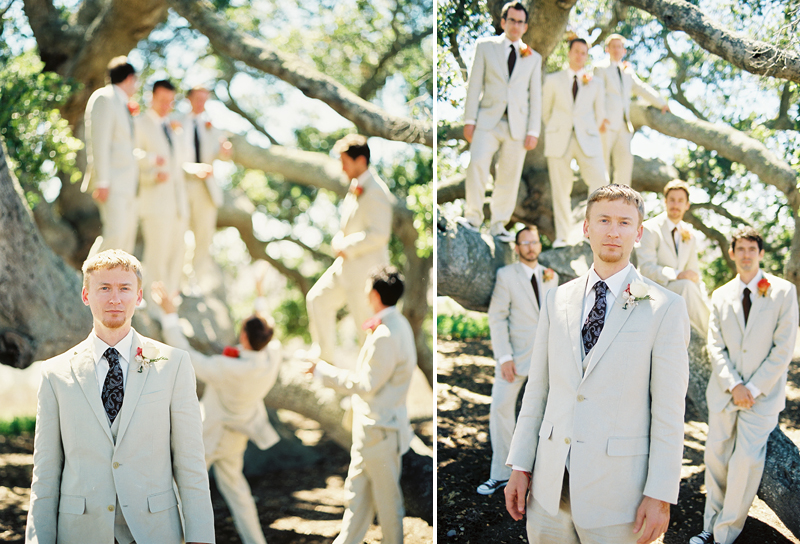 Stop holding your breath and crossing your fingers, because the time has finally come. A brand new film stock, unlike any before, is being released from Kodak! The new Portra400 "Incorporates Entertainment Imaging's KODAK VISION Film Technology" and is "the world’s finest grain high-speed color negative film" according to Eastman Kodak today. You know what this means? Still photographers will finally be able to capture the light that cinematographers have been spoiled with for years. You can see more on Kodaks website, KODAK PROFESSIONAL PORTRA 400 Film
Stop holding your breath and crossing your fingers, because the time has finally come. A brand new film stock, unlike any before, is being released from Kodak! The new Portra400 "Incorporates Entertainment Imaging's KODAK VISION Film Technology" and is "the world’s finest grain high-speed color negative film" according to Eastman Kodak today. You know what this means? Still photographers will finally be able to capture the light that cinematographers have been spoiled with for years. You can see more on Kodaks website, KODAK PROFESSIONAL PORTRA 400 Film
This is the dawn of a whole new line of light sensitive materials. Created for the hybrid workflow, the Vision technology harnesses light like no other emulsion. We have tested it's limits with our Nikon F3 250 exp. film backs, and processing at Technicolor for the past year. I cant tell you how excited I am! Vision in medium and large format! But not until October... So for now, in honor of the release of the new Kodak Portra400, we give you a taste of 35mm Vision technology.
35mm Kodak Vision3 250D up against Fuji PRO400H 6x7cm negative!
This is far from a fair comparison here. A 6x7 negative is 4 times the size of a 35mm frame, and the P67 SMC glass is the best around. I exposed 35mm 250D at ISO 400, and 220 400H at ISO 200. I performed straight scans of each on our Fuji Frontier at an 8x10 proportionate print resolution, then scaled directly to original magnification. You can see for yourself...
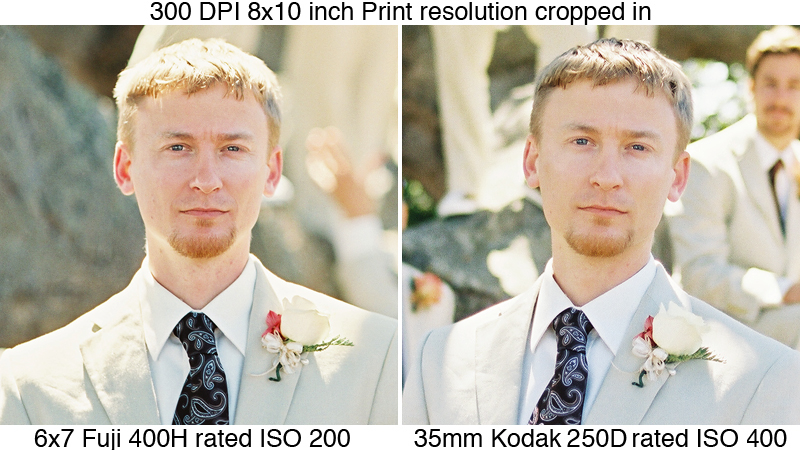
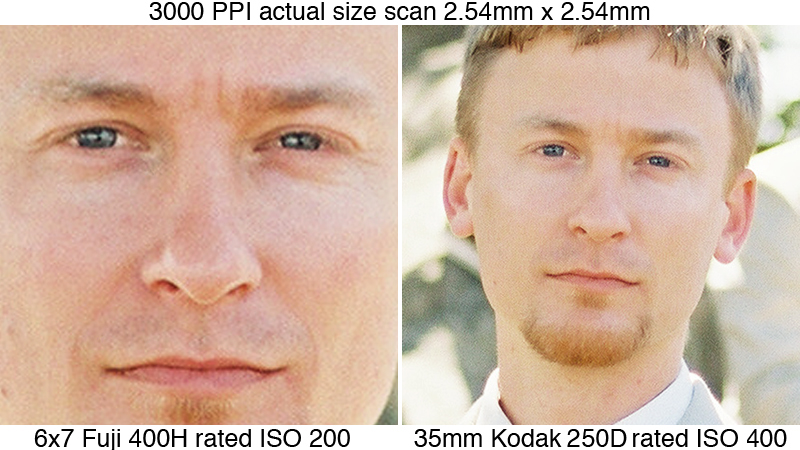
It is a brand new day and film is not dead, it's just entering a new generation. And it's heirs shall have more majesty as splendor than ever! c'mon... Say it with me... LONG LIVE FILM!
 For many artists straining to see in the dark of a digital age, the recent news of Fuji ending production of 400H in 220 can feel like the final blinding blow from the digital demagogues. After seeing Kodachrome, 800Z, and countless other beautiful stocks (not to mention Polaroid) vanish before our eyes, we have clung to the analoged daylight of the past. After all "Photography" breaks down to "the writing (archiving) of light" in greek, and as photographers we cherish moments of light. I recently received an alarmist text from a fresh photographer, choosing to shoot film, reading "Film is dead, Fuji is killing it!" Another such phone call left me with the image of a successful photographer weeping at her desk, after running into "discontinued" notifications online. I have followed up these emotional reactions with reassurance and rationality, but as these occurrences are becoming all too common, I decided offer our foresight to the public.
For many artists straining to see in the dark of a digital age, the recent news of Fuji ending production of 400H in 220 can feel like the final blinding blow from the digital demagogues. After seeing Kodachrome, 800Z, and countless other beautiful stocks (not to mention Polaroid) vanish before our eyes, we have clung to the analoged daylight of the past. After all "Photography" breaks down to "the writing (archiving) of light" in greek, and as photographers we cherish moments of light. I recently received an alarmist text from a fresh photographer, choosing to shoot film, reading "Film is dead, Fuji is killing it!" Another such phone call left me with the image of a successful photographer weeping at her desk, after running into "discontinued" notifications online. I have followed up these emotional reactions with reassurance and rationality, but as these occurrences are becoming all too common, I decided offer our foresight to the public.
The future may seem pretty dark, but to everything there is a time and a season, and you can't make an omelet without cracking a few eggs. And if Fuji's 400h is an exegetical egg, then Kodak's Vision3 is the Goose that's laying the golden egg! But platitudes aside, let me assure you that film is only going to get better! How do I know this? Because I have seen the future, and it's brighter than ever. You see, film is manufactured (and will continue to be for a long time coming) primarily for motion picture films. TV shows and movies pay millions of dollars per production to film manufacturers. So it is in the interest of; say Kodak, to spend all of it's R&D on motion picture stocks. This technology is only handed down to us, still photographers, years later; i.e. Kodak's celebrated Ektar 1oo is based off of a technology used by cinematographers for a decade.
As recently as this June kodak has been releasing the most exciting emulsions in their Vision3 line of film stocks. We have been shooting these ECN2 negative films since January, and working with Technicolor to have our 250 exposure rolls processed. Our journey into the future has been quite amazing! Our first test was high ISO 35mm 500T vs 800z in low light, and the results blew us away. We then followed up with some real world examples, and upped the ante by comparing 500T to 35mm 400H and 800Z in 220! Now I'm going to blow some minds...
We shoot the Vision3 500T film in our 35mm Nikon F3's with bulk backs, and one of our favorite setups for MF is our Pentax 6x7 with Fuji 400H. This is far from a fair comparison here. A 6x7 negative is 4 times the size of a 35mm frame, and the P67 SMC glass is the best around, not to mention 500T's native ISO is 1000 & tungsten balanced! But I figured what the heck... I exposed 35mm 500T at ISO 800, and 220 400H at ISO 200 (both wide angle lenses were shot wide open). I performed straight scans of each on our Fuji Frontier at an 8x10 proportionate print resolution, then scaled directly to original magnification. You can see for yourself...
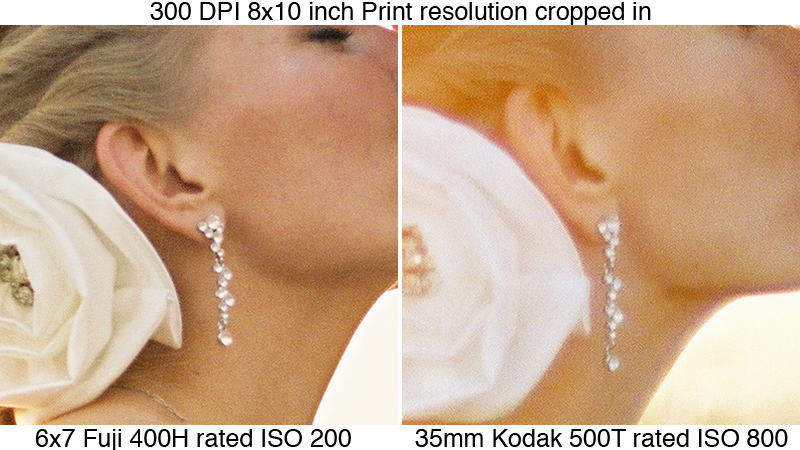
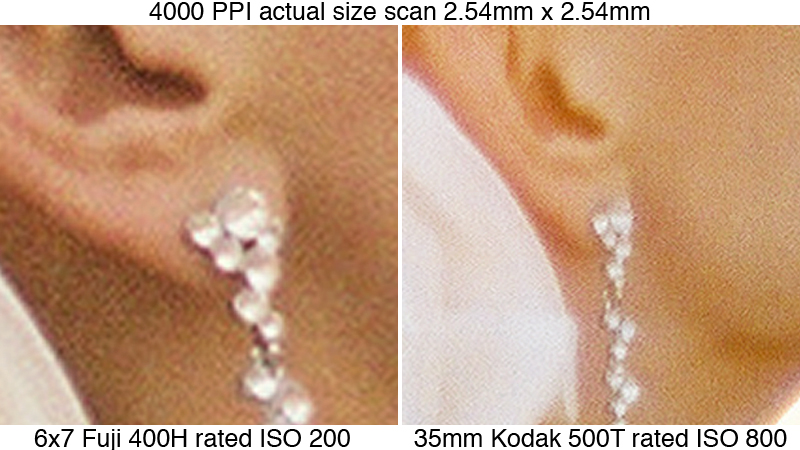
I know that the Pentax glass is superior, and the Nikon is a little softer wide open, but this stuff is ridiculous! Printed at 8x10 neither would have grain visible to naked eye, but the 35mm shot would actually have smoother texture! And just looking at the emulsion close up, I can't help but get excited about what "new" bright ideas Kodak has on the horizon for still photographers... Perhaps in medium format? :-)
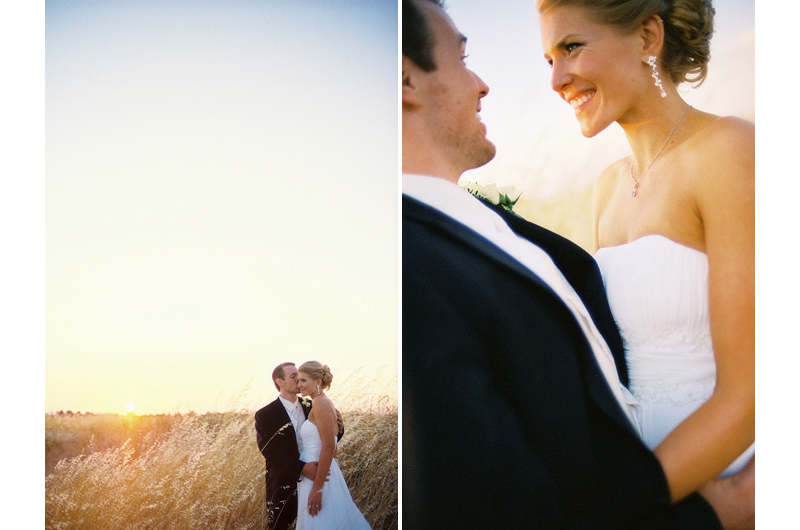

 Canonet QL17 f/1.7 Fuji 400H
Canonet QL17 f/1.7 Fuji 400H
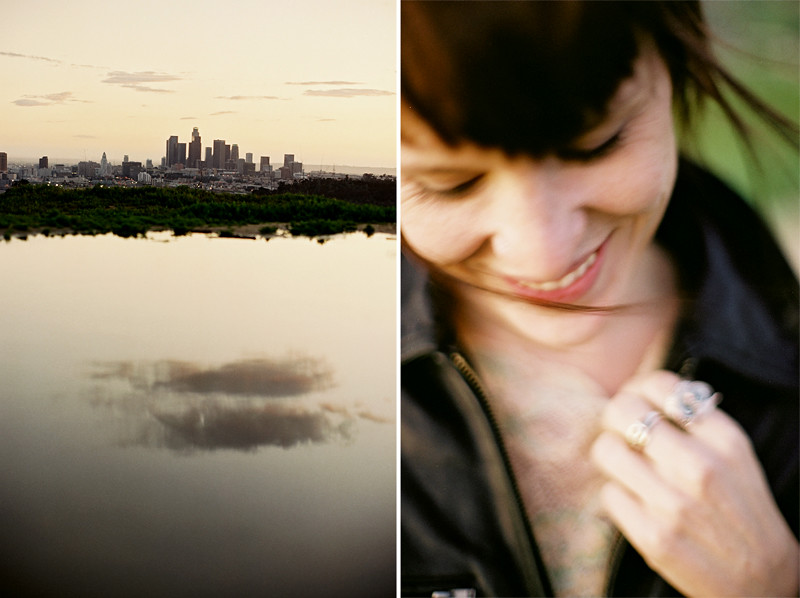 Nikon FE2Nikkor 50mm f/1.2 AIS Fuji 400H
Nikon FE2Nikkor 50mm f/1.2 AIS Fuji 400H
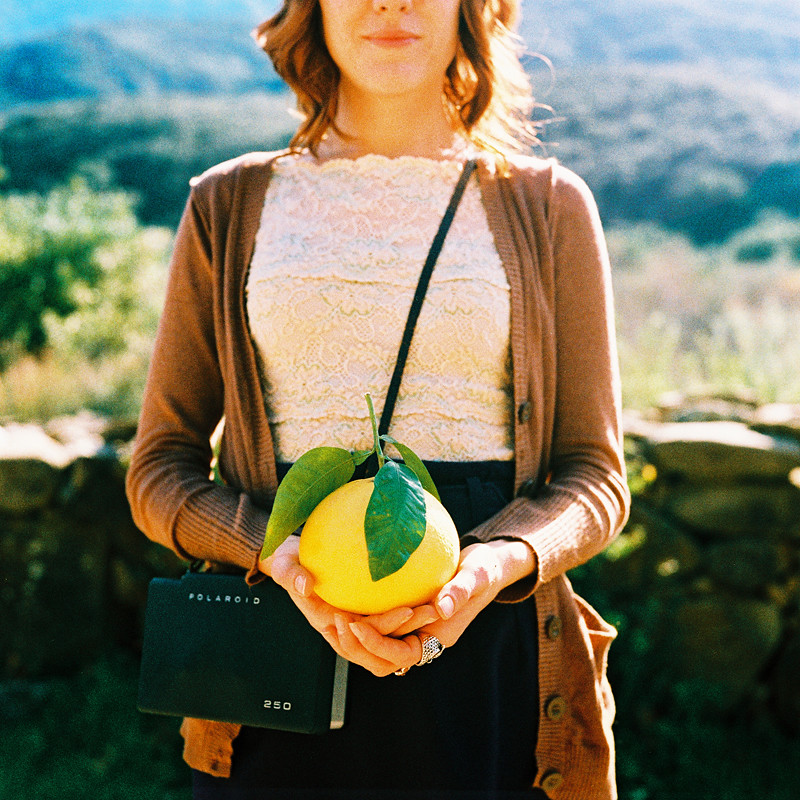 The colors in this film are just about as juicy as that swollen citrus! I just want to take a bite! Mmmm...Rollei 2.8C Xenotar
Fuji T64 120 Cross Processed
The colors in this film are just about as juicy as that swollen citrus! I just want to take a bite! Mmmm...Rollei 2.8C Xenotar
Fuji T64 120 Cross Processed
Everyone is raving about the new high ISO capabilities of digital, and the future of digital. What about the future of film? Well, one way to find out is to look to the motion picture industry. Any R&D into new emulsions by Kodak or Fuji is going to be for film's biggest clientele, Hollywood movies! It usually takes years (if ever) for the technology to trickle down to the still community; e.g. Kodak's Ektar 100 that was finally released to photographers years after the vision negative technology replaced older emulsions for movies circa 1996-2002. (Listen to Inside Analog Photo Radio's interview with a Kodak representative on Ektar's success HERE!) That film is amazing to us photographers today, but the technology is really over a decade old! Imagine a digital capture that old. Talk about dinosaur! Another film from Kodak that's a part of their Vision series motion picture films is their 500T. This film has yet to be packaged for still photographers, but we figured that we'd use our Leica Summicron 5cm for what it was designed, to test movie film!
This film is ECN-2, virtually the same as normal C-41 process 35mm but it has a Remjet antihalation layer for movie cameras that must be removed (it's like a black carbon coating on the base of the negatives). We paired it up against our favorite high ISO Fuji film that we love, PRO 800Z.
I shot in a mixed lighting situation, with wide range of exposure to demonstrate the film's latitude (digital could never touch this detail in light bulb's filament at any exposure). I light metered off the wall behind bird cage to let the purse overexpose, and the Louis Vuitton logo fall well under. We prefer to rate the 800Z at 400, so I started by rating both films at ISO 200 to test for overexposure. Then from there stopped down, step by step, all the way to metering at ISO 3200! Please keep in mind that there was no push processing on any of these negatives in standard C-41 chemistry, and they were straight scans, untouched from Richard Photo Lab.
Rated at ISO 200 (f/2.0 & 1/30th sec): 500T/800Z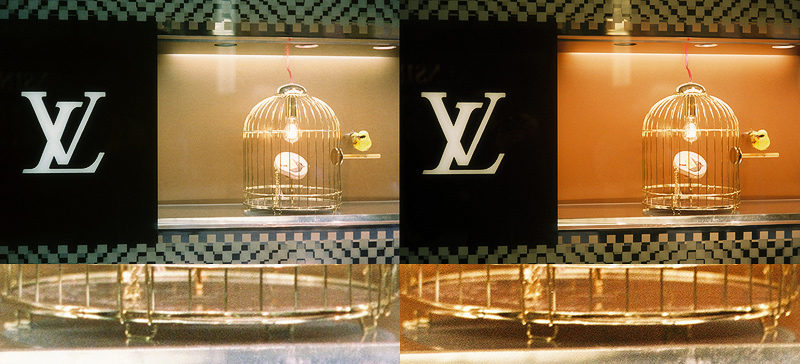 Rated at ISO 400 (f/2.0 & 1/60th sec): 500T/800Z
Rated at ISO 400 (f/2.0 & 1/60th sec): 500T/800Z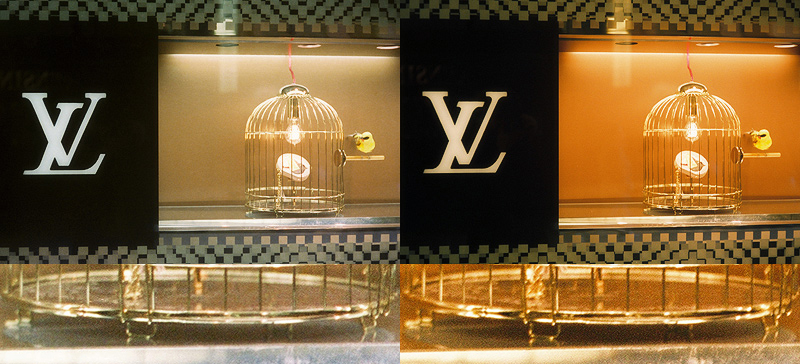 Rated at ISO 800 (f/2.0 & 1/125th sec): 500T/800Z
Rated at ISO 800 (f/2.0 & 1/125th sec): 500T/800Z Rated at ISO 1600 (f/2.0 & 1/250th sec): 500T/800Z
Rated at ISO 1600 (f/2.0 & 1/250th sec): 500T/800Z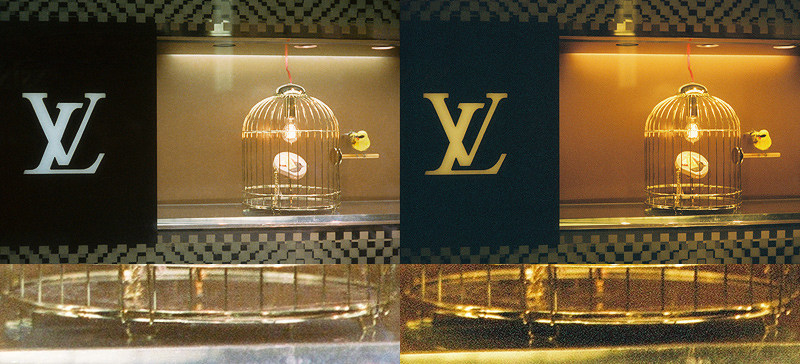 Rated at ISO 3200 (f/2.0 & 1/500th sec): 500T/800Z
Rated at ISO 3200 (f/2.0 & 1/500th sec): 500T/800Z I was blown away when I got the scans back! The 500T has virtually unlimited exposure range, and has better grain structure and shadow detail underexposed at ISO 3200 than the 800Z exposed at it's native ISO 800! Ignoring the fact that it's tungsten balanced film (meaning less color correction in common low light situations), this film destroys any Kodak film I've ever shot!!! Why has Kodak been sitting on this film?
I was blown away when I got the scans back! The 500T has virtually unlimited exposure range, and has better grain structure and shadow detail underexposed at ISO 3200 than the 800Z exposed at it's native ISO 800! Ignoring the fact that it's tungsten balanced film (meaning less color correction in common low light situations), this film destroys any Kodak film I've ever shot!!! Why has Kodak been sitting on this film?
Here are a few more comparisons in a real world situation, rating both at ISO 800 in camera...
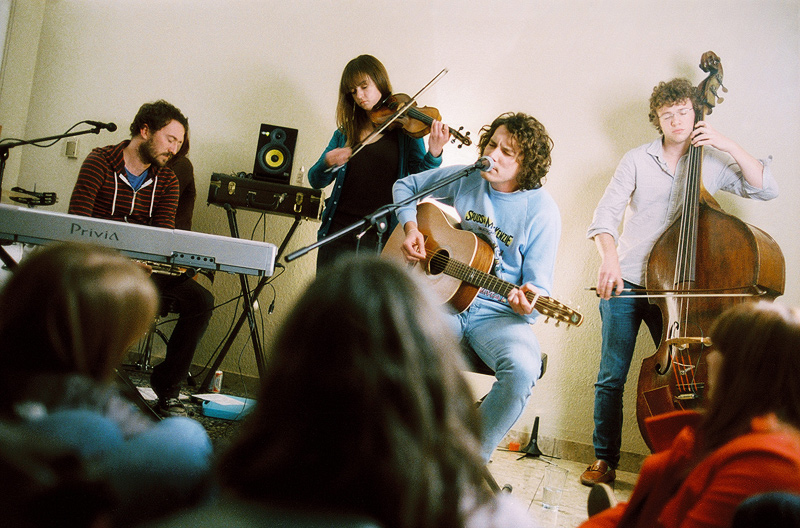

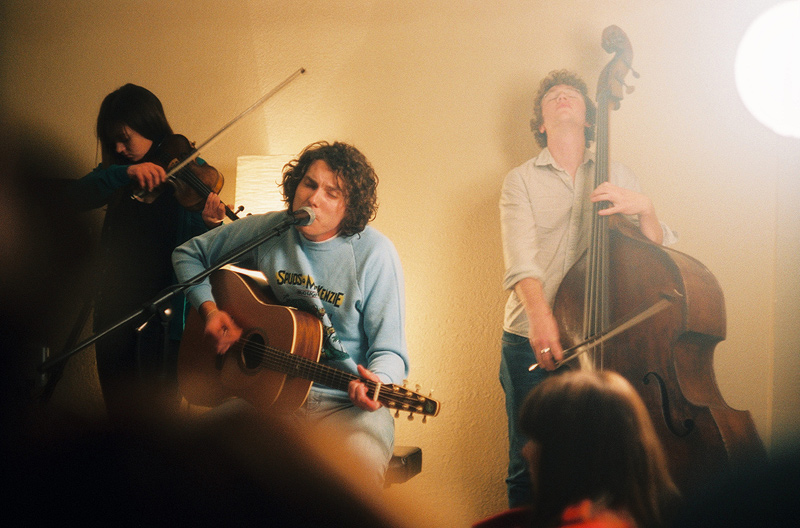
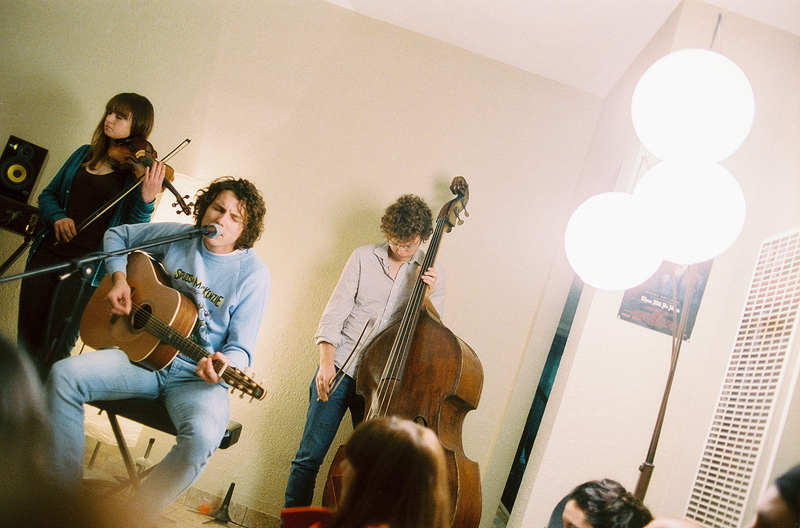
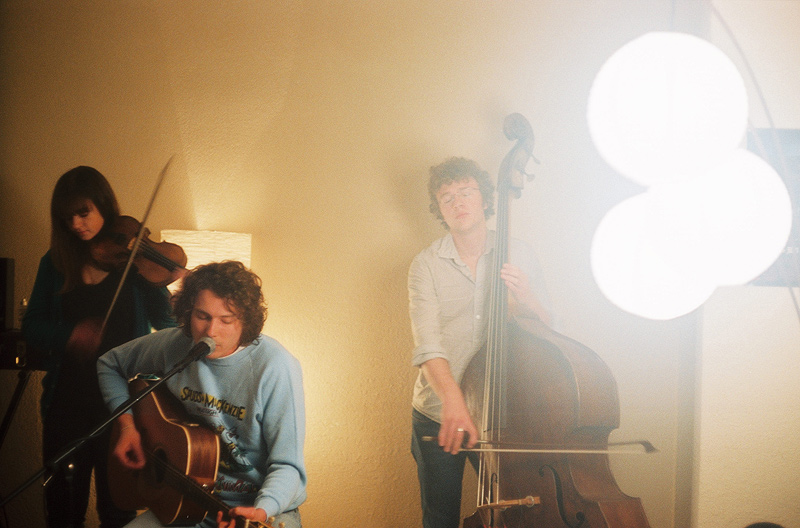
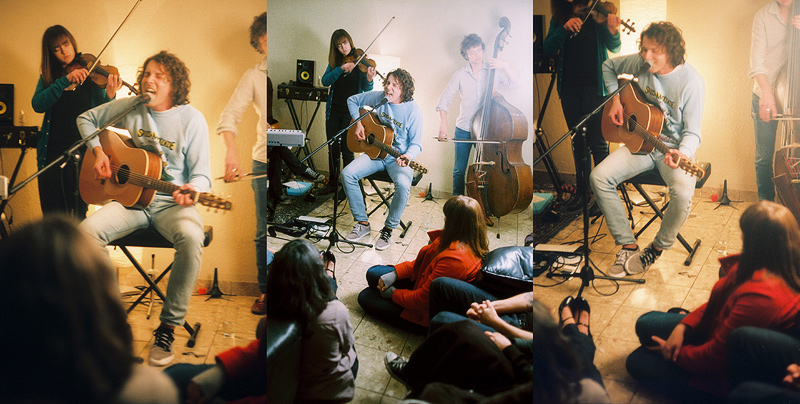 This just demonstrates the advances and potential in film, that are kept just out of arms reach, since the popularization of the "film is dead" ideology, when in fact film is still just maturing! Can you imagine if the same amount of R&D went into film these days as digital? Really it's the marketing dollars that make the popularity difference, resulting lower availability and research investment.
This just demonstrates the advances and potential in film, that are kept just out of arms reach, since the popularization of the "film is dead" ideology, when in fact film is still just maturing! Can you imagine if the same amount of R&D went into film these days as digital? Really it's the marketing dollars that make the popularity difference, resulting lower availability and research investment.
But hey, the new Digis. have high def. video now! The question is, are the new Blue Ray readers gonna be able to read all those lush word processor docs on your 5.25" floppy, that killed paper and ink so many years ago?
I remain hopeful...

![[Framed] Network](http://farm8.staticflickr.com/7081/7170441815_07085c2bf7_o.jpg)
![[Framed] Network](http://farm8.staticflickr.com/7071/7170441749_b54c989d81_o.jpg)
![[Framed] Network](http://farm9.staticflickr.com/8023/7170441641_531284aee6_o.jpg)
![[Framed] Network](http://farm8.staticflickr.com/7228/7170441491_1d5e6f84ed_o.jpg)
![[Framed] Network](http://farm8.staticflickr.com/7093/7170441407_993230e87a_o.jpg)
![[Framed] Network](http://farm8.staticflickr.com/7071/7355653924_80090317b6_o.jpg)
![[Framed] Network](http://farm8.staticflickr.com/7084/7170441127_d11e2c78dd_o.jpg)
![[Framed] Network](http://farm8.staticflickr.com/7215/7170441011_f2e269101d_o.jpg)
![[Framed] Network](http://farm8.staticflickr.com/7233/7170440371_2e3f66af9e_o.jpg)
![[Framed] Network](http://farm9.staticflickr.com/8152/7170420219_05cf1f2251_o.jpg)
![[Framed] Network](http://farm8.staticflickr.com/7078/7355632640_3c187128b4_o.jpg)
![[Framed] Network](http://farm8.staticflickr.com/7222/7355632554_e32e07dd52_o.jpg)
![[Framed] Network](http://farm8.staticflickr.com/7228/7170419901_32183f27e4_o.jpg)
![[Framed] Network](http://farm9.staticflickr.com/8026/7355632334_a35ac48d76_o.jpg)
![[Framed] Network](http://farm8.staticflickr.com/7103/7355632270_5594ba94e3_o.jpg)
![[Framed] Network](http://farm8.staticflickr.com/7216/7170419627_e93b141cb9_o.jpg)
![[Framed] Network](http://farm8.staticflickr.com/7079/7170419507_0df091e631_o.jpg)
![[Framed] Network](http://farm8.staticflickr.com/7099/7355631324_1811211de5_o.jpg)
 Welcome to the golden hour of film! The age old tradition of film photography has always possessed an inherent warmth and beauty, that transcends technical explanation. As photographers, we relish something called "The Golden Hour" (sometimes known as magic hour) which is the first and last hour of sunlight during the day, because the quality of light is such that everything becomes magically photogenic. Due to the diffusion of the sun's abundance of light, and the hues created by the atmosphere, everything is illuminated within photographic reach. Well, Kodak's new Portra400 has this magical quality packed right into the emulsion! No matter the lighting situation, Kodak's Vision Technology brings it within reach. Pretty much anything your eye can see now is visible within one frame. We have always loved film for this quality, but the limits have been stretched further than formerly possible.
Welcome to the golden hour of film! The age old tradition of film photography has always possessed an inherent warmth and beauty, that transcends technical explanation. As photographers, we relish something called "The Golden Hour" (sometimes known as magic hour) which is the first and last hour of sunlight during the day, because the quality of light is such that everything becomes magically photogenic. Due to the diffusion of the sun's abundance of light, and the hues created by the atmosphere, everything is illuminated within photographic reach. Well, Kodak's new Portra400 has this magical quality packed right into the emulsion! No matter the lighting situation, Kodak's Vision Technology brings it within reach. Pretty much anything your eye can see now is visible within one frame. We have always loved film for this quality, but the limits have been stretched further than formerly possible. The results don't blow me away with this first shot. It's a suitable replacement for 400h for sure, and that's the main concern really. But when I went in and scanned it way too large, I found amazing resolution, and the beautiful grain that was rumored. It's much smoother and sharper than the old emulsions, once you begin to print above 16x20 at least. ;-)
The results don't blow me away with this first shot. It's a suitable replacement for 400h for sure, and that's the main concern really. But when I went in and scanned it way too large, I found amazing resolution, and the beautiful grain that was rumored. It's much smoother and sharper than the old emulsions, once you begin to print above 16x20 at least. ;-) I knew that the Fuji could take it, but I was pleasantly surprised to find that the Portra actually held up much better. These are all straight scans (untouched) from our Frontier by the way. The Portra doesn't get as muddy in the highlights and has much cleaner color. But again, comforting but not mind blowing.
I knew that the Fuji could take it, but I was pleasantly surprised to find that the Portra actually held up much better. These are all straight scans (untouched) from our Frontier by the way. The Portra doesn't get as muddy in the highlights and has much cleaner color. But again, comforting but not mind blowing. Normally, I wouldn't shoot color film in this ugly of light. Maybe 3200 Delta if I can get away with it. I did not push process this film, even though I underexposed the highlights up to 5 stops. Fuji begins to look horrible at 1 stop under, but the Portra looks exponentially better in comparison each stop under! At 12,000 ISO the fuji begins to even loose the detail in the light bulbs, but the new Portra 400 keeps some shadow detail up to 6400 ISO! To give you an idea, a guy with a 5D was having trouble getting their faces without loosing the sign at 6400. I will probably never underexpose film again, but I will most definitely push this Golden film to 3200.
Normally, I wouldn't shoot color film in this ugly of light. Maybe 3200 Delta if I can get away with it. I did not push process this film, even though I underexposed the highlights up to 5 stops. Fuji begins to look horrible at 1 stop under, but the Portra looks exponentially better in comparison each stop under! At 12,000 ISO the fuji begins to even loose the detail in the light bulbs, but the new Portra 400 keeps some shadow detail up to 6400 ISO! To give you an idea, a guy with a 5D was having trouble getting their faces without loosing the sign at 6400. I will probably never underexpose film again, but I will most definitely push this Golden film to 3200. "It's our favorite time of light, just before the day kisses the night. You see the red winged blackbirds fly. The sun's a big ol' lazy eye. When the day is bending low, and rolling fields begin to glow, feels like we traveled all this way, just so I could hear you say, It's our favorite time of light... It's our favorite time of light, just before the day kisses the night. You see the red winged blackbirds fly. The sun's a big ol' lazy eye. The moon is waiting in the wings, dreaming up some midnight song to sing, and I know we'll be okay evry time I hear you say, it's our favorite time of light." - Over The Rhine
"It's our favorite time of light, just before the day kisses the night. You see the red winged blackbirds fly. The sun's a big ol' lazy eye. When the day is bending low, and rolling fields begin to glow, feels like we traveled all this way, just so I could hear you say, It's our favorite time of light... It's our favorite time of light, just before the day kisses the night. You see the red winged blackbirds fly. The sun's a big ol' lazy eye. The moon is waiting in the wings, dreaming up some midnight song to sing, and I know we'll be okay evry time I hear you say, it's our favorite time of light." - Over The Rhine Stop holding your breath and crossing your fingers, because the time has finally come. A brand new film stock, unlike any before, is being released from Kodak! The new Portra400 "Incorporates Entertainment Imaging's KODAK VISION Film Technology" and is "the world’s finest grain high-speed color negative film" according to Eastman Kodak today. You know what this means? Still photographers will finally be able to capture the light that cinematographers have been spoiled with for years. You can see more on Kodaks website, KODAK PROFESSIONAL PORTRA 400 Film
Stop holding your breath and crossing your fingers, because the time has finally come. A brand new film stock, unlike any before, is being released from Kodak! The new Portra400 "Incorporates Entertainment Imaging's KODAK VISION Film Technology" and is "the world’s finest grain high-speed color negative film" according to Eastman Kodak today. You know what this means? Still photographers will finally be able to capture the light that cinematographers have been spoiled with for years. You can see more on Kodaks website, KODAK PROFESSIONAL PORTRA 400 Film

 For many artists straining to see in the dark of a digital age, the recent news of Fuji ending production of 400H in 220 can feel like the final blinding blow from the digital demagogues. After seeing Kodachrome, 800Z, and countless other beautiful stocks (not to mention Polaroid) vanish before our eyes, we have clung to the analoged daylight of the past. After all "Photography" breaks down to "the writing (archiving) of light" in greek, and as photographers we cherish moments of light. I recently received an alarmist text from a fresh photographer, choosing to shoot film, reading "Film is dead, Fuji is killing it!" Another such phone call left me with the image of a successful photographer weeping at her desk, after running into "discontinued" notifications online. I have followed up these emotional reactions with reassurance and rationality, but as these occurrences are becoming all too common, I decided offer our foresight to the public.
For many artists straining to see in the dark of a digital age, the recent news of Fuji ending production of 400H in 220 can feel like the final blinding blow from the digital demagogues. After seeing Kodachrome, 800Z, and countless other beautiful stocks (not to mention Polaroid) vanish before our eyes, we have clung to the analoged daylight of the past. After all "Photography" breaks down to "the writing (archiving) of light" in greek, and as photographers we cherish moments of light. I recently received an alarmist text from a fresh photographer, choosing to shoot film, reading "Film is dead, Fuji is killing it!" Another such phone call left me with the image of a successful photographer weeping at her desk, after running into "discontinued" notifications online. I have followed up these emotional reactions with reassurance and rationality, but as these occurrences are becoming all too common, I decided offer our foresight to the public.


 The colors in this film are just about as juicy as that swollen citrus! I just want to take a bite! Mmmm...Rollei 2.8C Xenotar
Fuji T64 120 Cross Processed
The colors in this film are just about as juicy as that swollen citrus! I just want to take a bite! Mmmm...Rollei 2.8C Xenotar
Fuji T64 120 Cross Processed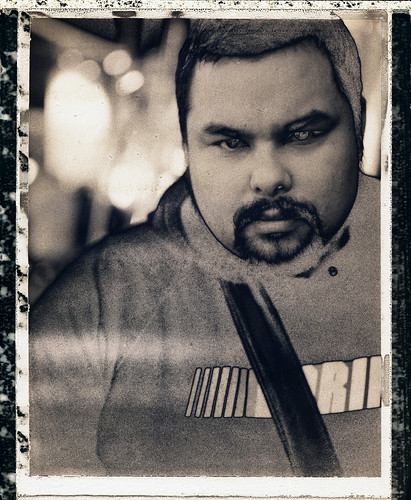
 Jonathan Canlas has silver in his veins!
Jonathan Canlas has silver in his veins!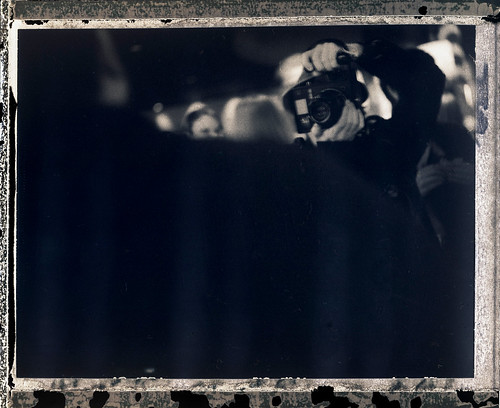
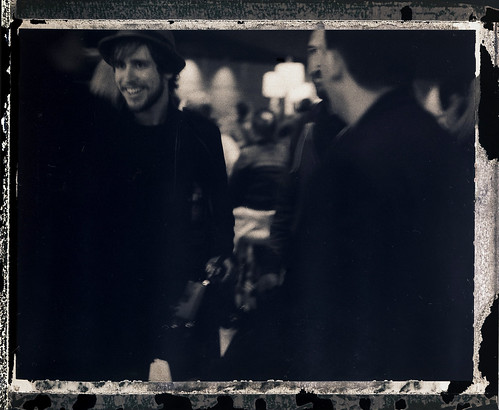 The MGM Grand smells like goop!
The MGM Grand smells like goop! And Vegas won't let me sleep!
And Vegas won't let me sleep! Rated at ISO 400 (f/2.0 & 1/60th sec): 500T/800Z
Rated at ISO 400 (f/2.0 & 1/60th sec): 500T/800Z Rated at ISO 800 (f/2.0 & 1/125th sec): 500T/800Z
Rated at ISO 800 (f/2.0 & 1/125th sec): 500T/800Z Rated at ISO 1600 (f/2.0 & 1/250th sec): 500T/800Z
Rated at ISO 1600 (f/2.0 & 1/250th sec): 500T/800Z Rated at ISO 3200 (f/2.0 & 1/500th sec): 500T/800Z
Rated at ISO 3200 (f/2.0 & 1/500th sec): 500T/800Z I was blown away when I got the scans back! The 500T has virtually unlimited exposure range, and has better grain structure and shadow detail underexposed at ISO 3200 than the 800Z exposed at it's native ISO 800! Ignoring the fact that it's tungsten balanced film (meaning less color correction in common low light situations), this film destroys any Kodak film I've ever shot!!! Why has Kodak been sitting on this film?
I was blown away when I got the scans back! The 500T has virtually unlimited exposure range, and has better grain structure and shadow detail underexposed at ISO 3200 than the 800Z exposed at it's native ISO 800! Ignoring the fact that it's tungsten balanced film (meaning less color correction in common low light situations), this film destroys any Kodak film I've ever shot!!! Why has Kodak been sitting on this film?




 This just demonstrates the advances and potential in film, that are kept just out of arms reach, since the popularization of the "film is dead" ideology, when in fact film is still just maturing! Can you imagine if the same amount of R&D went into film these days as digital? Really it's the marketing dollars that make the popularity difference, resulting lower availability and research investment.
This just demonstrates the advances and potential in film, that are kept just out of arms reach, since the popularization of the "film is dead" ideology, when in fact film is still just maturing! Can you imagine if the same amount of R&D went into film these days as digital? Really it's the marketing dollars that make the popularity difference, resulting lower availability and research investment.